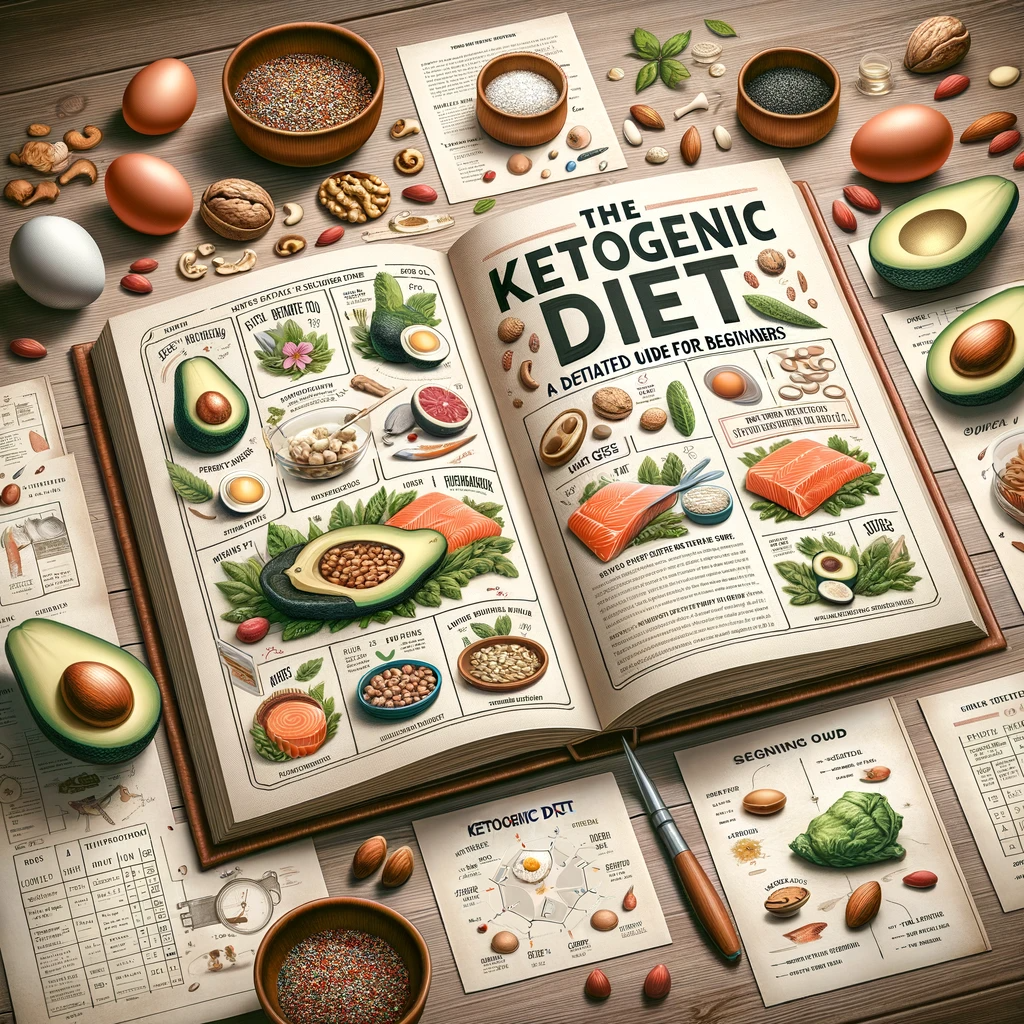The ketogenic diet: detailed guide for beginners

March 9, 2024
The ketogenic diet, or keto diet, is a low-carbohydrate, high-fat diet that offers numerous health benefits. Recent studies indicate that this diet can promote weight loss and improve overall health (1). In addition, the ketogenic diet may be useful in treating conditions such as type 2 diabetes, cancer, epilepsy, and Alzheimer’s disease (2, 3, 4, 5).
In this detailed beginner’s guide, we will explore the basic principles of the ketogenic diet, the various types of the keto diet, foods to avoid and recommended foods, potential side effects and associated risks, as well as provide useful tips for following the keto diet correctly.
What is the Ketogenic Diet?
The ketogenic diet is a dietary regimen characterized by very low carbohydrate intake and high fat consumption. By drastically reducing carbohydrate intake, the body enters a metabolic state called ketosis.
During ketosis, the body becomes extremely efficient at burning fat to produce energy. In addition, the liver converts fats into ketones, which can provide energy for the brain (6).
Ketogenic diets can significantly reduce blood sugar and insulin levels. This, along with the increase in ketones, may offer some health benefits (7, 8).
Types of Ketogenic Diet
There are several types of ketogenic diets, and the choice depends on personal preferences and health goals. The main types of keto diets include:
-
Standard Ketogenic Diet (SKD): This is the most common type of ketogenic diet and involves very low carbohydrate intake, moderate protein consumption, and high fat intake. Typically, the SKD diet includes 70% fat, 20% protein and only 10% carbohydrates (9).
-
Cyclic Ketogenic Diet (CKD ): This type of diet includes periods of higher carbohydrate replenishment, such as 5 ketogenic days followed by 2 carbohydrate days.
-
Targeted Ketogenic Diet (TKD): This type of diet allows carbohydrates to be consumed around workouts.
-
High Protein Ketogenic Diet: This type of diet is similar to the standard ketogenic diet, but includes more protein. The typical proportion is 60 percent fat, 35 percent protein, and 5 percent carbohydrates.
Importantly, the standard ketogenic diet and the high-protein diet are the most studied. Cyclic and target ketogenic diets are more advanced methods and are mainly used by bodybuilders or athletes (10).
How Does Ketosis Work?
Ketosis is a metabolic state in which the body uses fat as fuel instead of carbohydrates. This state is achieved by drastically reducing carbohydrate intake and increasing fat intake.
When few carbohydrates are consumed, the body depletes glycogen stores in the liver and muscles. As a result, the body begins to use fats as an energy source. The liver converts fats into ketones, which are then used as fuel for the brain and other organs (11).
To achieve ketosis, it is necessary to limit carbohydrate intake to about 20-50 grams per day and consume healthy fats such as meat, fish, eggs, nuts and vegetable oils. It is also important to moderate protein intake, as excessive protein consumption can slow the transition to ketosis (12).
Ketosis can be confirmed by blood, urine, or breath tests, which measure the levels of ketones produced by the body. In addition, certain symptoms such as increased thirst, dry mouth, frequent urination, and decreased appetite may indicate that one has entered ketosis (13).
Benefits of the Ketogenic Diet for Weight Loss
The ketogenic diet is an effective way to lose weight and reduce risk factors for certain diseases (14). Numerous studies have shown that the ketogenic diet can be as effective as a low-fat diet for long-term weight loss (15).
In addition, the ketogenic diet can lead to a reduction in diastolic blood pressure and triglyceride levels (16).
For example, a review of 13 studies found that following a ketogenic diet very low in carbohydrates was slightly more effective for long-term weight loss than a low-fat diet. People following the ketogenic diet lost an average of 0.9 kg more than the group following the low-fat diet (17).
Another study of 34 elderly people showed that those who followed a ketogenic diet for 8 weeks lost almost five times more body fat than those who followed a low-fat diet (18).
Increased ketone levels, reduced blood sugar and improved insulin sensitivity may play a key role in weight loss on the ketogenic diet (19).
Ketogenic Diet and Type 2 Diabetes
Type 2 diabetes is characterized by changes in metabolism, high blood sugar levels and impaired insulin function (20). The ketogenic diet can help lose excess fat, which is closely related to type 2 diabetes, prediabetes and metabolic syndrome (21, 22, 23, 24).
An older study showed that the ketogenic diet improved insulin sensitivity by 75% (25). A small study of women with type 2 diabetes also showed that following a ketogenic diet for 90 days significantly reduced levels of hemoglobin A1C, an indicator of long-term blood sugar control (26).
Another study of 349 people with type 2 diabetes found that those who followed a ketogenic diet lost an average of 11.9 kg in two years. This is an important benefit considering the correlation between weight and type 2 diabetes (27).
In addition, those who followed the ketogenic diet experienced improved blood sugar control and reduced use of diabetes medications during the study (27).
Other Benefits of the Ketogenic Diet
The ketogenic diet was originally developed as a treatment for neurological diseases such as epilepsy. However, studies have shown that the ketogenic diet can have benefits for a wide range of health conditions:
-
Heart disease: The ketogenic diet can improve risk factors such as body fat, HDL (good) cholesterol levels, blood pressure and blood sugar (28, 29).
-
Cancer: The ketogenic diet is currently being studied as an adjunctive treatment for cancer, as it may help slow the growth of tumors (30, 31).
-
Alzheimer’s disease: The ketogenic diet could reduce the symptoms of Alzheimer’s disease and slow its progression (32, 33).
-
Epilepsy: The ketogenic diet may cause a significant reduction in seizures in epileptic children (3).
-
Parkinson’s disease: Although further research is needed, one study showed that the ketogenic diet helped improve symptoms of Parkinson’s disease (34).
-
Polycystic ovary syndrome: The ketogenic diet may reduce insulin levels, which could play a key role in polycystic ovary syndrome (35, 36).
-
Brain trauma: Some research suggests that the ketogenic diet may improve brain trauma outcomes (37).
It is important to note that research on many of these topics is not yet conclusive, and further studies are needed to confirm the benefits of the ketogenic diet in these conditions.
Foods to Avoid on the Ketogenic Diet
In the ketogenic diet, you should avoid all foods high in carbohydrates. Here is a list of foods you should reduce or completely eliminate from your diet:
-
Sugary foods: carbonated soft drinks, fruit juices, sweets, ice cream, candy, etc.
-
Grains or starches: wheat products, rice, pasta, breakfast cereals, etc.
-
Fruits: all fruits, except small portions of berries such as strawberries.
-
Legumes: peas, beans, lentils, chickpeas, etc.
-
Root and tuber vegetables: potatoes, sweet potatoes, carrots, Jerusalem artichokes, etc.
-
Low-fat diet foods: low-fat mayonnaise, salad dressings and condiments.
-
Some condiments or sauces: barbecue sauce, honey mustard, teriyaki sauce, ketchup, etc.
-
Unhealthy fats: refined vegetable oils, mayonnaise, etc.
-
Alcohol: beer, wine, liquor, cocktails.
-
Sugar-free diet foods: sugar-free candies, syrups, puddings, sweeteners, desserts, etc.
Remember that these foods are high in carbohydrates and can disrupt ketosis. It is essential to read food labels and check the carbohydrate content to determine if a food is suitable for the ketogenic diet.
Recommended Foods on the Ketogenic Diet
The ketogenic diet relies mainly on foods high in healthy fats and protein, with a limited intake of carbohydrates. Here are some foods you can include in your ketogenic diet:
-
Meat: red meat, steak, ham, sausage, chicken, turkey, pork, lamb, etc.
-
Fatty fish: salmon, trout, tuna, mackerel, etc.
-
Eggs: whole eggs or omega-3 eggs.
-
Butter and cream: butter made from animal fats, cream made from animal fats.
-
Cheese: unprocessed cheeses such as cheddar, goat, cream, blue or mozzarella.
-
Nuts and seeds: almonds, walnuts, flaxseeds, pumpkin seeds, chia seeds, etc.
-
Healthy oils: extra virgin olive oil, avocado oil.
-
Avocados: whole or freshly prepared guacamole.
-
Low-carb vegetables: green vegetables, tomatoes, onions, peppers, etc.
-
Seasonings: salt, pepper, herbs and spices.
It is important to base your diet primarily on whole, unprocessed foods. You can find a complete list of low-carb foods suitable for the ketogenic diet.
Sample Food Plan for a Week on the Ketogenic Diet.
To help you get started, here is a sample food plan for one week on the ketogenic diet:
Monday
-
Breakfast: vegetable muffins and eggs with tomatoes.
-
Lunch: chicken salad with olive oil, feta cheese, olives and mixed salad.
-
Dinner: salmon with asparagus cooked in butter.
Tuesday
-
Breakfast: omelet with eggs, tomato, basil and spinach.
-
Lunch: smoothie of almond milk, peanut butter, spinach, cocoa powder and stevia with sliced strawberries.
-
Dinner: tacos with cheese shell and salsa.
Wednesday
-
Breakfast: chia seed pudding with almond milk, coconut and blackberries.
-
Lunch: shrimp and avocado salad.
-
Dinner: pork chops with parmesan cheese, broccoli and salad.
Thursday
-
Breakfast: omelet with avocado, salsa, peppers, onions and spices.
-
Lunch: a handful of walnuts and celery with guacamole and salsa.
-
Dinner: chicken stuffed with pesto and cream cheese, with a side of grilled zucchini.
Friday
-
Breakfast: unsweetened Greek yogurt with peanut butter, cocoa powder and berries.
-
Lunch: ground beef tacos in a cheese shell with sliced peppers.
-
Dinner: baked cauliflower with cheese and mixed vegetables.
Saturday
-
Breakfast: cheese pancakes with blueberries and grilled mushrooms.
-
Lunch: zucchini and beet salad “noodles.”
-
Dinner: white fish cooked in olive oil with kale and toasted pine nuts.
Sunday
-
Breakfast: fried eggs with mushrooms.
-
Lunch: sesame chicken and broccoli.
-
Dinner: spaghetti squash with meat sauce.
Try to vary vegetables and meat in the long run, as each type offers different nutrients and health benefits.
Healthy Snacks on the Ketogenic Diet.
If you are hungry between meals, here are some healthy snacks you can consume on the ketogenic diet:
-
Fatty meat or fish.
-
Cheese.
-
A handful of nuts or seeds.
-
Ketogenic sushi.
-
Olives.
-
One or two hard-boiled or stuffed eggs.
-
Ketogenic snack bars.
-
90% dark chocolate.
-
Whole Greek yogurt with nut butter and cocoa powder.
-
Peppers and guacamole.
It is important to choose low-carb snacks that satisfy your hunger without interrupting ketosis.
Tips for Following the Ketogenic Diet at a Restaurant.
Many restaurant meals can be adapted to the ketogenic diet. Most restaurants offer meat or fish dishes. You can order these dishes and replace carbohydrate-rich foods with extra vegetables.
Egg meals are also a good option, such as an omelet or eggs and bacon.
At Mexican restaurants, you can enjoy meat with extra cheese, guacamole, salsa, and sour cream. For dessert, you can order a mixed cheese board or berries with cream.
Remember to be careful with sauces and condiments, as many of them may contain added sugars. You can drink water, unsweetened tea, coffee or other sugar-free beverages.
When you go to dinners or get-togethers with friends or relatives, you might consider bringing your own food so that you can follow the ketogenic diet properly and not give in to temptation.
Side Effects and How to Minimize Them
Although the ketogenic diet is generally safe for most healthy people, there may be some side effects during the initial adaptation. Some common symptoms, known as “ketogenic flu,” may include diarrhea, constipation, vomiting, lack of energy, increased hunger, sleep disturbances, nausea, digestive discomfort, and reduced physical performance (38).
To minimize these side effects, you can try some suggestions:
-
Start gradually: you can begin with a low-carb diet before switching completely to the ketogenic diet to accustom your body to the new changes.
-
Increase water and salt intake: the ketogenic diet can affect the body’s water and mineral balance. Adding extra salt to meals or taking mineral supplements can help.
-
Gradually increase physical activity: exercise can help the body adapt to ketosis more quickly, but it is advisable to gradually increase the intensity of physical activity.
-
Eat until you are full: it is important to eat enough food to satisfy your appetite and not limit yourself too much in calories. The ketogenic diet often leads to weight loss without intentional calorie restriction.
-
Get enough sleep: quality sleep is important for the body’s recovery and adaptation to the ketogenic diet. Try to get at least 7-8 hours of sleep per night.
If side effects persist or worsen, you should consult a health care professional.
Risks Associated with the Ketogenic Diet.
Although the ketogenic diet has its benefits, there are some associated risks that must be considered.
-
Low blood protein: The ketogenic diet can lead to low blood protein levels. It is important to make sure you get enough protein through sources such as meat, fish, eggs, cheese, etc.
-
Excess fat in the liver: some people may develop excessive fat accumulation in the liver due to increased fat intake on the ketogenic diet. It is important to monitor saturated fat consumption and maintain a balance between the types of fats consumed.
-
Kidney stones: the ketogenic diet may increase the risk of kidney stone formation because it reduces calcium excretion in the urine. It is important to drink plenty of water to reduce the risk of kidney stones.
-
Micronutrient deficiencies: the ketogenic diet can lead to deficiencies in essential vitamins and minerals. It is important to consume a variety of healthy foods and consider taking supplements if necessary.
-
Type 2 diabetes and SGLT2 drugs: taking SGLT2 drugs for type 2 diabetes can increase the risk of diabetic ketoacidosis, a dangerous condition that increases blood acidity. People taking these drugs should avoid the ketogenic diet (40, 41).
It is important to talk to a doctor before starting any diet, including the ketogenic diet, to assess the specific risks and benefits for you.









